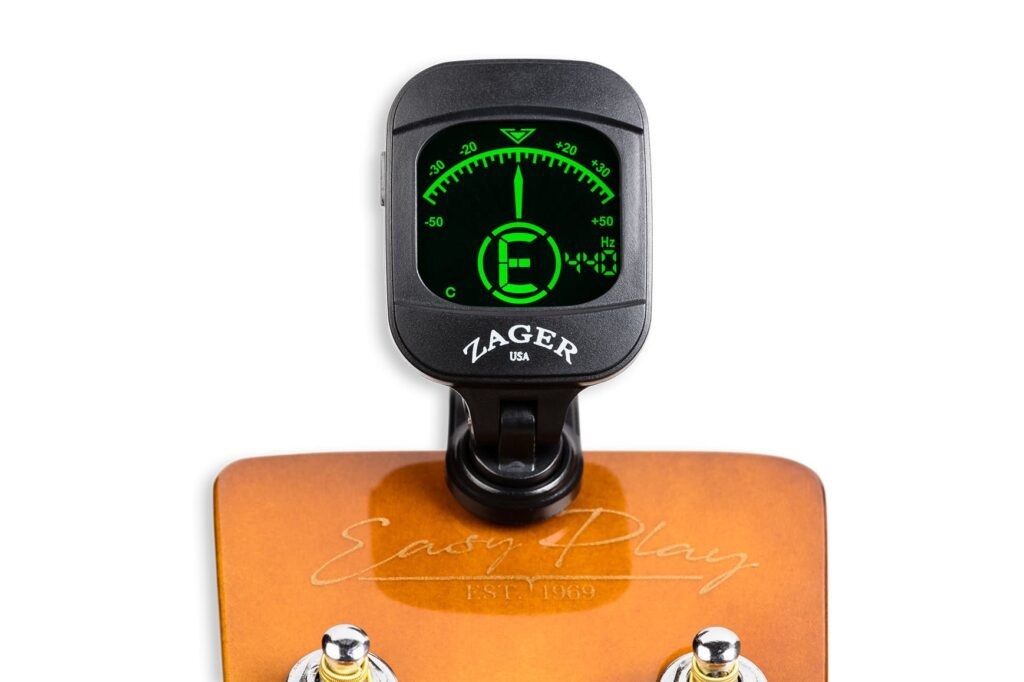Tuning a guitar is a fundamental skill, ensuring your instrument produces the harmonious sounds needed for chords, scales, and the tones you desire. While tuning a standard six-string guitar becomes second nature with practice, the twelve-string acoustic guitar presents a unique challenge. With double the strings, achieving precise intonation and managing increased string tension requires a more nuanced approach.
For those new to the twelve-string guitar, the task of tuning can seem daunting. The sheer number of strings, the need to tune pairs in unison and octaves, and the overall string tension can initially feel complex. Even slight deviations in tuning on a twelve-string can significantly alter its rich, resonant tone. Regular tuning is therefore essential to keep your 12-string guitar sounding its best.
Fortunately, this guide will provide you with a detailed, step-by-step process to master tuning your twelve-string guitar, ensuring you can unlock its full sonic potential.
Understanding the Twelve String Guitar: Key Differences
Before diving into the tuning process, it’s helpful to understand what sets a twelve-string guitar apart from its six-string counterpart. The most obvious difference, of course, is the number of strings. A twelve-string guitar features six courses of strings, with each course containing two strings.
These pairs are tuned in unison or in octaves, creating a richer, fuller sound than a standard guitar. The strumming techniques used on a twelve-string often need to be precise to articulate each string clearly and avoid muddiness. The resulting sound, however, is a distinctive chorus effect that adds depth and complexity, making the 12-string guitar a favorite for genres like folk, rock, and country.
While the top two courses (E and B) are typically tuned in unison, the lower four courses (G, D, A, E) are tuned in octaves. This means one string in the pair is tuned to the standard pitch, while the other is tuned an octave higher. This configuration contributes significantly to the instrument’s characteristic shimmering tone.
The doubled strings also result in increased tension on the guitar’s neck and body. This added tension is crucial for achieving the desired pitch and resonance, but it also means twelve-string guitars can be slightly harder to play initially. Fretting notes requires more pressure, and the neck is under greater stress, potentially making the instrument more susceptible to issues if not properly maintained. However, understanding this construction is the first step in learning how to care for and tune your twelve-string effectively.
Step-by-Step Tuning Guide for a 12-String Guitar
The standard tuning for a 12-string guitar is EADGBE, the same as a six-string guitar, but with the added octave strings. Some players prefer to tune down a whole step to DGCFAD to reduce string tension, but for this guide, we will focus on standard E tuning.
When tuning, you’ll tune each course of strings to the corresponding note in EADGBE, starting from the thickest courses to the thinnest. In each pair, one string will be the standard gauge, and the other will be thinner, tuned an octave higher. Typically, when looking down at the guitar in playing position, the higher octave string is positioned to the right of the standard string.
Let’s break down the tuning process course by course:
- 6th Course (Lowest E): Start with the thickest string pair, representing the lowest E. Tune the thicker string to E. Then, tune the thinner string of this pair to E, one octave higher than the thicker string.
- 5th Course (A): Move to the next pair. Tune the thicker string to A. Tune the thinner string of this pair to A, one octave higher.
- 4th Course (D): Tune the thicker string of this pair to D. Tune the thinner string to D, one octave higher.
- 3rd Course (G): Tune the thicker string to G. Tune the thinner string to G, one octave higher.
- 2nd Course (B): For the B course, both strings are tuned in unison. Tune both strings to B at the same pitch.
- 1st Course (Highest E): Similarly to the B course, the two strings in the highest E course are tuned in unison. Tune both strings to high E at the same pitch.
This process might seem intricate at first because of the octave pairings, but with practice and a systematic approach, tuning a 12-string guitar becomes manageable. Remember to tune incrementally, making small adjustments and checking your tuning frequently as you go.
Essential Tuning Methods and Tools
While you can tune a 12-string guitar by ear, using a tuner is highly recommended, especially for beginners. Accurate tuning is crucial for a 12-string to sound its best, and modern tuning tools make this process much easier. Several types of tuners are readily available:
Chromatic Tuners
 Zager High Accuracy Sonic Guitar Tuner
Zager High Accuracy Sonic Guitar Tuner
Image alt text: Close-up of a Zager High Accuracy Sonic Guitar Tuner, a clip-on chromatic tuner attached to a guitar headstock, displaying a clear digital note reading against a blurred background of a wooden guitar.
Source: Zager High Accuracy Sonic Guitar Tuner
A chromatic tuner is an invaluable tool for any guitarist, particularly for tuning a 12-string. Unlike standard guitar tuners that are pre-set for specific guitar tunings, a chromatic tuner can detect and display any note within the chromatic scale. This versatility is essential for tuning the octave strings on a 12-string and for experimenting with alternate tunings if desired.
Chromatic tuners come in various forms:
- Clip-on tuners: These compact tuners clip onto the guitar’s headstock and detect vibrations directly from the instrument. They are convenient, accurate, and often work well even in noisy environments.
- Pedal tuners: Primarily used by electric guitarists, pedal tuners are placed in the signal chain and offer precise tuning on stage. They can also be used for acoustic guitars when plugged in or with a microphone.
- Microphone tuners: These tuners use a built-in microphone to detect sound. They can be less accurate in noisy environments compared to clip-on tuners but can be useful in quiet settings.
Using a chromatic tuner is straightforward. Pluck a string, and the tuner will display the note and indicate whether it’s sharp (too high) or flat (too low). Adjust the tuning peg until the tuner indicates the correct note and pitch. Repeat this process for each string, paying close attention to both strings in each course of your 12-string guitar.
Guitar Tuner Apps
 Smartphone displaying a guitar tuner app interface
Smartphone displaying a guitar tuner app interface
Image alt text: A smartphone screen displaying a guitar tuner app interface with colorful visual indicators of pitch accuracy, set against a blurred background suggesting a music practice environment.
In today’s digital age, guitar tuner apps offer another accessible and convenient tuning method. These apps use your smartphone’s microphone to detect the pitch of the strings and provide visual feedback, similar to a chromatic tuner.
Guitar tuner apps are generally user-friendly and often offer features beyond basic tuning, such as alternate tunings, metronomes, and chord libraries. Many are available for free or at a low cost on both Android and iOS platforms. The accuracy of a tuner app depends on the quality of your device’s microphone, but modern smartphones generally have microphones capable of accurate tuning.
Popular and highly-rated guitar tuner apps include:
- GuitarTuna: A widely used app known for its accuracy and ease of use, GuitarTuna supports various instruments and tunings.
- Boss Tuner App: From the renowned musical instrument company Boss, this app offers a professional-grade tuning experience with a clear and responsive interface.
To use a tuner app, simply open the app, allow it microphone access, and pluck a string on your 12-string guitar. The app will analyze the pitch and guide you to tune the string accurately. These apps are an excellent option for quick tuning at home, practice, or even on the go.
Tips for Tuning Your 12-String Guitar
Tuning a 12-string guitar can present some unique challenges. Here are a few tips to make the process smoother:
- Start with the thicker strings: Begin tuning with the lower courses (E, A, D, G) and move towards the higher courses (B, E). This helps to distribute tension more evenly across the neck.
- Tune in small increments: Avoid making large tuning adjustments at once, especially with the octave strings. Small, incremental adjustments are more accurate and help prevent string breakage.
- Check tuning frequently: As you tune one string, the tension changes can slightly affect the tuning of other strings. After tuning each course, go back and check the tuning of the previous courses and make any necessary adjustments.
- Use new strings: Old strings can be harder to tune and less likely to hold their tuning. If you’re having persistent tuning issues, consider changing your strings.
- Consider a professional setup: If you continue to struggle with tuning or playability, a professional guitar setup can make a significant difference. A luthier can adjust the guitar’s action, neck relief, and intonation, making it easier to play and stay in tune.
Zager 12-String Guitars
Zager Guitars is known for producing instruments that prioritize playability and sound quality, and their 12-string models are no exception. The ZAD900CE 12 String Solid Spruce/Rosewood Acoustic Electric AURA Pro Series is a highly regarded instrument, crafted with premium materials like solid Sitka Spruce and Indian Rosewood. Zager guitars are designed with player comfort in mind, featuring custom bracing and string spacing that make them easy to play, even for beginners.
For those interested in experiencing the rich sound of a 12-string, exploring Zager 12-string guitar models or listening to a sound demo can provide valuable insights into the quality and tone these instruments offer.
FAQ About Tuning 12-String Guitars
Is a 12-string guitar harder to tune?
Yes, tuning a 12-string guitar is generally considered more complex than tuning a 6-string guitar due to the doubled strings and octave pairings. However, with practice and the right tools like chromatic tuners or tuner apps, it becomes manageable.
Can I use a guitar tuner app for a 12-string guitar?
Yes, many guitar tuner apps work perfectly well for tuning 12-string guitars. Apps like GuitarTuna and Boss Tuner are popular choices and offer accurate tuning capabilities.
Are chords the same on a 12-string guitar?
Yes, the chord shapes and positions are the same on a 12-string guitar as on a 6-string guitar. You play the same chord forms; however, the resulting sound is richer and fuller due to the doubled strings.
What is standard 12-string guitar tuning?
The standard tuning for a 12-string guitar is EADGBE, the same as a standard 6-string guitar, but with octave strings added to the lower four courses (E, A, D, G). The B and high E courses are tuned in unison.
Conclusion
Tuning a twelve-string acoustic guitar may seem challenging at first, but with a clear understanding of the process and the right tools, it’s a skill you can master. By following this step-by-step guide, utilizing chromatic tuners or tuner apps, and practicing regularly, you’ll be able to keep your 12-string guitar sounding its resonant best. Embrace the unique sonic character of the 12-string, and enjoy the rich, full tones it brings to your music.

